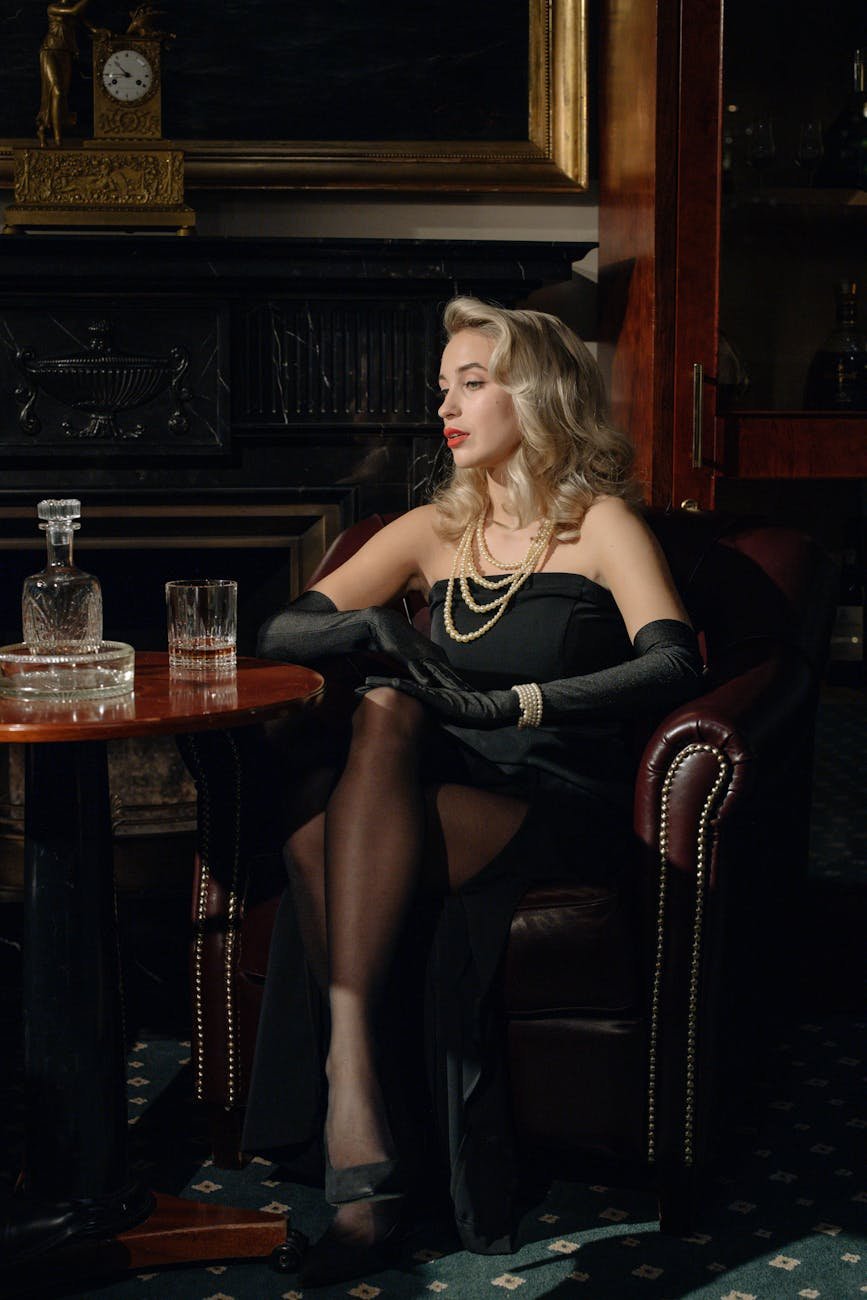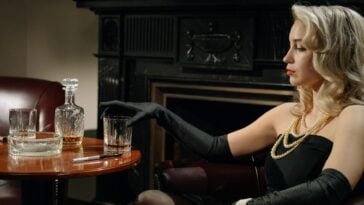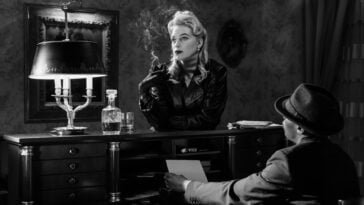Introduction to the Femme Fatale Archetype
The femme fatale archetype, often portrayed as an enigmatic and beguiling woman, stands out as a timeless figure in literature, film, and art. The term, French for “fatal woman,” hints at the character’s dangerous allure. Historically, the femme fatale emerged during antiquity, with early examples found in various mythologies and classical texts. Figures such as the Sirens in Homer’s “Odyssey” and Cleopatra from Egyptian history depict early iterations of this enigmatic women who wield power through seduction and cunning.
As societies transitioned into modern eras, the femme fatale evolved, becoming a staple in noir films and detective stories of the early 20th century. Prominent silver screen icons like Barbara Stanwyck in “Double Indemnity” and Rita Hayworth in “Gilda” personified this captivating archetype. These characters were often portrayed as manipulative yet irresistibly attractive, dangerous yet desirable—a paradox that has fascinated audiences for decades.
The allure of the femme fatale lies in her complexity and mystique. She is neither a pure villain nor a straightforward hero; her motivations are often shrouded in ambiguity, driving narratives full of suspense and intrigue. The femme fatale’s ability to blend charm, intelligence, and ruthlessness challenges traditional gender roles, making her a uniquely powerful character in a male-dominated world.
This archetype endures in popular culture because it touches on universal themes of power, control, and the interplay between love and betrayal. Contemporary depictions in movies, television, and literature continue to draw inspiration from the classic femme fatale, while adding new nuances that reflect evolving societal attitudes.
In sum, the femme fatale remains a compelling figure because she embodies both danger and allure, a complex duality that captivates and confounds our understanding of human nature. Her timeless appeal underscores the enduring fascination with characters who exist in the gray areas of morality, continuously challenging and reshaping our perceptions through each iteration.
Historical Evolution of the Femme Fatale
The archetype of the femme fatale has long held a place within cultural narratives, tracing its roots back to ancient myths and legends. This evolution can be seen as a reflection of changing societal views on women, highlighting their perceived power and its inherent danger. Ancient stories offer some of the earliest examples of the femme fatale, with figures like the Sirens in Greek mythology. These enchantresses lured sailors to their doom with their mesmerizing voices, representing both allure and deadly peril.
In Biblical tales, we encounter Delilah, whose name has become synonymous with seduction and betrayal. Delilah’s cunning and manipulation of Samson, leading to his downfall, encapsulates the dual nature of the femme fatale character – alluring yet dangerous. These early portrayals underscore a lingering societal anxiety about female power and sexuality, casting such figures in a often malevolent light.
Moving into the 20th century, the femme fatale found new life in film noir. Perhaps one of the most iconic representations from this era is Phyllis Dietrichson in the classic movie ‘Double Indemnity’. Phyllis embodies the seductive manipulator, using her charm and allure to ensnare an unsuspecting victim into a murder plot. Her character, like many film-noir femme fatales, represents a nuanced evolution of the archetype, adding layers of psychological complexity and moral ambiguity to the trope.
This progression from ancient myths to modern cinema reflects broader shifts in societal attitudes towards women. As society has oscillated between reverence and suspicion towards female agency and independence, the femme fatale has evolved correspondingly. Each era’s portrayal has been influenced by its unique cultural and social contexts, shaping how female characters who wield power and influence are perceived and depicted.
Therefore, the femme fatale remains a compelling and multifaceted character, constantly evolving to mirror the anxieties and aspirations of the time. Her journey through history is a testament to the enduring fascination with women who defy conventional norms and wield their power in surprising, sometimes unsettling, ways.
Psychological Dimensions: What Makes a Femme Fatale?
The archetype of the femme fatale is one deeply rooted in psychological complexity, characterized by a distinct blend of intelligence, charm, manipulation, and independence. These traits combine to create a persona that is both alluring and perilous, drawing others into a web of seduction and intrigue. Understanding the psychological makeup of a femme fatale involves delving into the motivations and mental frameworks that drive her actions.
At the core of a femme fatale’s demeanor lies exceptional intelligence. This intelligence is not merely academic; it manifests as a keen understanding of human psychology, an innate ability to read people, and a strategic mind capable of anticipating reactions and behaviors. Combined with a high degree of charm, the femme fatale employs her wit and allure to captivate others, often utilizing her attractiveness to gain the upper hand in various situations.
Manipulation is another hallmark trait of the femme fatale. This extends beyond simple deceit; it involves a sophisticated orchestration of one’s environment and the people within it. Using cunning and duplicity, she maneuvers through social and personal landscapes, achieving her objectives with precision. Such manipulation is often perceived as dangerous because it undermines the trust and stability within relationships, leading to an inevitable conflict between her desires and societal norms.
Independence is yet another defining feature. A femme fatale typically exudes a strong sense of self-reliance, often stemming from past experiences or a calculated decision to live outside traditional constraints. This independence can be seductive in its own right, presenting a figure who is in control of her destiny and unanchored by conventional expectations.
Psychological theories postulate that these qualities are associated with danger and seduction due to a combination of innate predispositions and formative experiences. For instance, evolutionary psychology suggests that such traits may have developed as survival mechanisms, allowing the femme fatale to navigate complex social hierarchies and protect herself in hostile environments. Similarly, psychoanalytic theories might interpret her behavior as a response to past traumas or unfulfilled emotional needs, manifesting through a persona that deflects vulnerability and projects power.
The background and experiences of a femme fatale play critical roles in shaping her identity. Whether driven by ambition, revenge, or personal liberation, her motivations are often linked to her past and her vision for the future. Thus, the femme fatale emerges as a multifaceted character whose psychological dimensions are as intriguing as they are daunting, embodying a perennial enigma in the narrative of human interaction.
The Femme Fatale in Modern Media
The femme fatale archetype, long a staple in classic noir and early 20th-century literature, continues to evolve and maintain its enigmatic allure in contemporary media. Modern interpretations span a variety of platforms, including movies, television series, books, and video games, illustrating how the character has been adapted while adhering to or diverging from traditional representations.
In recent cinema, characters such as Amy Dunne from “Gone Girl” (2014) and Villanelle from the TV series “Killing Eve” exemplify the femme fatale’s modern iteration. Amy Dunne’s intricate schemes and manipulative prowess reflect a continuity with classic traits, such as cunning and unpredictability. Villanelle, on the other hand, embodies a blend of lethal skill and charm, diverging from the archetype by introducing a more complex psychological profile highlighted by dark humor and vulnerabilities.
Books also continue to present intriguing femme fatales. Gillian Flynn’s novels frequently feature cunning women who utilize their intellect and sexuality to navigate complex situations, her characters epitomizing this archetype in contemporary literature. Conversely, modern graphic novels, such as Frank Miller’s “Sin City,” portray femme fatales like Ava Lord, who utilize their beauty and ruthlessness in visually compelling ways unique to the graphic narrative form.
The video game industry has seen notable examples as well, with characters like Ada Wong from the “Resident Evil” series and Bayonetta from the eponymous game. Ada Wong’s stealth, intelligence, and combat proficiency typify the deadly allure of the traditional femme fatale, while Bayonetta breaks the mold with her over-the-top abilities and self-empowered presence, allowing players to experience this archetype in interactive, dynamic fashion.
Modern audiences have shown a mixed reception to these characters. While some appreciate the complexity and power of the contemporary femme fatale, critiquing traditional gender norms in the process, others argue that these portrayals can sometimes perpetuate negative stereotypes. Regardless, the continued fascination with the femme fatale in modern media speaks to the enduring appeal and enigmatic mystique of this archetype.
Cultural Impact and Influence
The archetype of the femme fatale extends far beyond literature and film, permeating various aspects of culture, including fashion, music, and visual arts. This enigmatic figure has not only captivated audiences but has also sculpted societal attitudes towards women, gender roles, and sexuality. The essence of the femme fatale embodies a powerful, seductive allure balanced with an element of danger – a juxtaposition that has made a lasting impression on multiple cultural domains.
In fashion, the influence of the femme fatale is palpable. Iconic designers such as Versace, Dior, and Givenchy have often drawn inspiration from the deadly allure of this character. This can be observed in collections that feature bold, structured silhouettes, dark color palettes, and luxurious fabrics. The femme fatale fashion exudes an air of confidence and mystery, leading women to embrace clothing that signifies both empowerment and sophistication.
Similarly, in the realm of music, the femme fatale has inspired numerous artists and songs. For instance, Madonna’s “Vogue” and Lana Del Rey’s “Born to Die” channel the characteristics of the femme fatale, blending sensuality with a subtle threat. These artists, through their music and visual performances, have shaped how the femme fatale is perceived, promoting a sense of agency and complexity in female characters.
Visual arts, including film and photography, are arenas where the femme fatale continues to hold a prominent place. Directors like Alfred Hitchcock and David Lynch have crafted timeless masterpieces featuring femme fatale characters who captivate with their mix of beauty and menace. Likewise, contemporary photographers such as Helmut Newton have immortalized the femme fatale through arresting visual imagery that highlights the provocative nature of this archetype.
The pervasive presence of the femme fatale in popular culture offers a lens through which to view evolving attitudes towards women. She challenges traditional gender roles and societal norms, presenting a figure that is both feared and revered. Cultural icons like Jessica Rabbit, Catwoman, and Lady Gaga exemplify how the femme fatale character has influenced and continues to mold contemporary societal perceptions, illustrating the enduring allure and complexity of this fascinating archetype.
Criticism and Controversy
The femme fatale archetype has long been a subject of criticism and controversy, eliciting a range of interpretations and responses from scholars, critics, and feminists. One central critique concerns the potential reinforcement of harmful stereotypes. The femme fatale is often depicted as deceitful, manipulative, and dangerous, traits that can inadvertently perpetuate the notion of women being inherently duplicitous and untrustworthy. This portrayal risks endorsing an outdated and negative view of femininity, aligning closely with the trope of the “evil woman” who uses her charms to ensnare men.
Feminist perspectives on the femme fatale are particularly complex. On one hand, some feminists argue that this archetype subverts traditional gender norms by portraying women as powerful and autonomous, capable of exerting influence and control in a male-dominated world. The femme fatale’s ability to navigate and manipulate societal constraints can be seen as a form of resistance against patriarchal structures. However, others contend that this figure ultimately reinforces patriarchal values by reducing women to one-dimensional characters defined by their sexuality and deceitfulness. This dichotomy presents a significant point of tension within feminist discourse.
The debate extends to literary and cinematic criticism, where scholars remain divided on the implications of the femme fatale. Some argue that these characters offer a critical commentary on the dynamics of power and sexuality, providing a complex and nuanced exploration of gender roles. In contrast, others see the continued use of the femme fatale as a lazy narrative device that promotes regressive views. The complexity of this debate highlights the evolving nature of cultural and feminist interpretations of the femme fatale over time.
Ultimately, the femme fatale remains a potent symbol within popular culture, embodying both empowerment and controversy. As societal views on gender and power continue to evolve, so too will the interpretations and criticisms of this enduring archetype.
Behind the Scenes: Creating a Femme Fatale
The creation of a femme fatale character is a nuanced and intricate process that requires collaboration among writers, directors, and actors. Renowned screenwriter Linda Woolverton, who has penned several compelling femme fatales in her career, emphasizes the significance of layered storytelling. “A femme fatale cannot just be mysterious for the sake of it; she needs depth. Her backstory, motivations, and nuances must be meticulously crafted to resonate with the audience,” Woolverton states. This depth often manifests through the character’s dialogue which is generally sharp, provocative, and laced with double entendres, adding layers to her enigmatic persona.
From a directorial perspective, individuals like Alfred Hitchcock have mastered the art of weaving intricate visual motifs that serve to underscore the femme fatale’s mystique. Hitchcock once remarked, “It’s not just what she says, but what is left unsaid that intrigues the audience.” This deliberate ambiguity keeps audiences on edge, always guessing about her true intentions. Subtle visual cues, such as lingering close-ups and shadowy lighting, contribute significantly to the femme fatale’s aura of mystery and danger.
Actors who portray femme fatales undertake the challenging task of balancing vulnerability with an underlying threat. Scarlett Johansson, known for her complex roles, notes, “Portraying a femme fatale requires an awareness of the character’s duality. One must navigate the tightrope between charm and menace, making sure not to overplay either element.” To achieve this, actors often employ a variety of techniques, such as evocative body language and controlled vocal inflections, to imbue their performances with subtlety and depth.
The wardrobe also plays a crucial role in bringing the femme fatale to life. Costume designer Edith Head, who famously worked on numerous classic films, believed that “Every garment a femme fatale wears should tell a story.” The choice of attire—often sleek, stylish, and predominately in dark tones—conveys much about the character’s seductive and dangerous nature. The wardrobe, complemented by strategic lighting and camera angles, helps in constructing the femme fatale’s captivating visual identity.
Thus, through a confluence of evocative dialogue, nuanced performances, strategic direction, and symbolic wardrobe, the creation of a femme fatale becomes a profound collaborative effort. Each element, meticulously crafted and seamlessly integrated, contributes to the enigmatic allure that makes the femme fatale a timeless archetype in storytelling.
The Future of the Femme Fatale
As we delve into the future of the femme fatale, it becomes apparent that this complex archetype will evolve to reflect the shifting landscape of societal norms and the strides made towards gender equality. Historically, the femme fatale has often been depicted as a mysterious and seductive figure, but she has also embodied various toxic stereotypes. With changing societal attitudes, the femme fatale is poised for reinterpretation, allowing for a more nuanced and empowering portrayal.
The ongoing conversations surrounding gender equality and representation foster a fertile ground for redefining the femme fatale. With an increasing awareness of intersectionality, future representations are likely to showcase more diverse backgrounds and experiences. This shift not only widens the range of stories but also enriches the character’s depth, stepping away from one-dimensional tropes.
Moreover, the future femme fatale could signify empowerment rather than manipulation. In emerging narratives, her allure and intelligence may be portrayed as strengths rather than tools for exploitation. This change could foster a more positive image, illustrating her as a figure who challenges the system and asserts control over her destiny. Such a portrayal aligns well with contemporary values of agency and self-determination, rendering the character relevant to modern audiences.
The influence of technology and digital media cannot be overlooked in the evolution of the femme fatale. With the rise of social media and digital storytelling platforms, there is a newfound opportunity for creators to reinvent this archetype in innovative ways. These mediums allow for immediate feedback and interaction, ensuring that representations resonate with increasingly discerning and diverse audiences.
In essence, the femme fatale stands on the brink of transformation. As media continues to evolve and our understanding of gender dynamics deepens, the archetype will likely move towards more varied and empowering representations. The future is ripe with possibilities, promising a richer, multifaceted interpretation that both honors the character’s roots and propels her into new, exciting dimensions.




